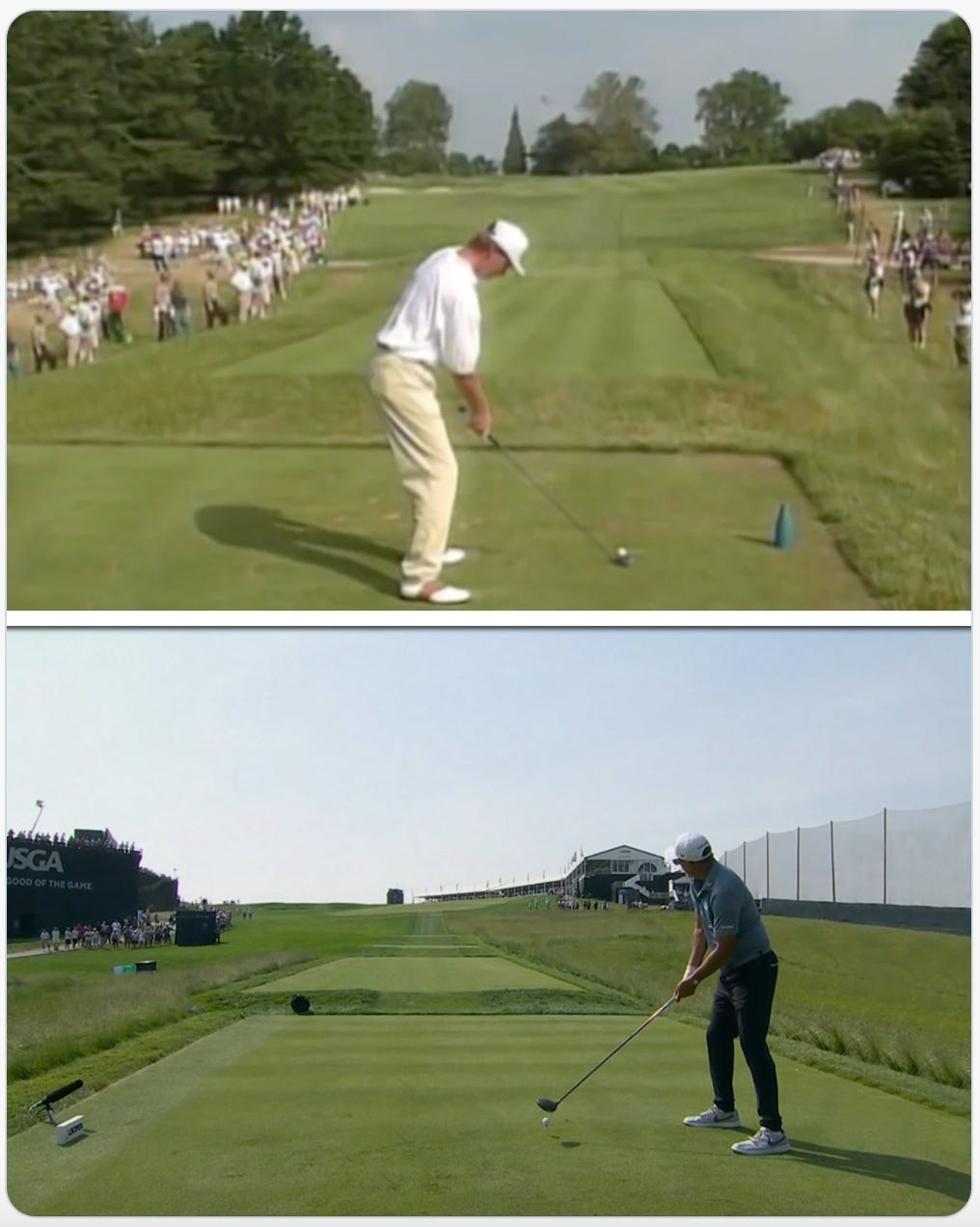When Fashions Shift, It's Hard to Not Go Too Far
You may want to know my opinion on Israel's attack on Iran.
But I really don’t want to think about the Israel-Iran war at the moment. I’ve been thinking about Israel since 1973 and Iran since 1978. I’m tired. What I want to think about instead is finishing my post on the rise and fall of trees on the U.S. Open golf course, Oakmont.
I like writing about trends in golf course aesthetics because the common politicized explanations obviously don’t apply. For example, you can’t blame Trump or Wokeness or Gay Race Communism or whatever (although maybe you can blame Trump, as a golf course builder, a little bit) for the chainsawing of every tree but one within the perimeter of the Oakmont County Club, a robber baron era golf course outside Pittsburgh that is currently hosting its record-setting tenth U.S. Open golf championship.
Gay Race Communism is not welcome at Oakmont. Yet, Oakmont has still undergone extreme shifts in golf fashion over the last 80 years, as can be seen in these views from the 17th tee in 1994 (top) and 2025 (bottom) from Jamie Kennedy:
The Oakmont property, a rare stretch of western Pennsylvania that’s not too severely hilly for optimal golf, presumably was heavily forested in American Indian times. Then settlers chopped the trees down for farming. The steel-making Fownes family bought the treeless land and opened the Oakmont golf course on it in 1903.
At that point, golf was only about 15 years old in the United States and its tastes were dominated by those of Scotland, the home of golf. Scotland was producing many of the most successful businessmen in the world at the time (e.g., steelman and golfer Andrew Carnegie), so ambitious American businessmen flocked to the game in the hopes that whatever it was the Scots were getting out of playing golf would rub off on them and their net worths.
Golf courses originated in Scotland on the grass covered “linksland” sand dunes along the coast (the “links” link the land and the sea). The thrifty Scots wouldn’t devote good cropland to a mere game, so they played their national sport on marginal soil that couldn’t grow wheat or lumber, just grass for sheep. The golfers and sheep could share the golf course.
For instance, here’s Trump International Scotland in Aberdeen:
So, when the Fownes family ruled Oakmont in the early decades of the 20th Century, there were no trees, as on a proper Scottish course.
Paywall here.
When golf came to America in the late 1880s, North America was strikingly lacking in Scottish style sand dunes. I’m not sure why, probably something related to prevailing winds and the Gulf Stream not causing sand to pile up along the shore as is so common in the British Isles.
And huge numbers of potential golfers lived inland, such as in Pittsburgh. In America, there were few sand dunes (although the golf world discovered the Sand Hills of remote Nebraska in the 1990s and have been building Scottish-style courses on them ever since), but trees loved to grow.
As American golfers came to dominate the highest realms of golf competition from the 1920s onward, their tree-lined inland American home golf courses became more fashionable.
And trees have advantages besides their beauty, such as providing shade during hot American summers.
And they offer exciting challenges to golfers to curve their shots around them. Here’s Rory McIlroy hooking his now famous shot around the huge tree on the left edge of the par 5 15th hole over the pond at Augusta National to set himself up to win the 2025 Masters:
So only a few big money American golf clubs like Oakmont maintained the old fashioned Scottish prejudice against trees.
After World War II, the Pennsylvania Turnpike was carved through the middle of Oakmont. So the club broke down and planted trees along the expressway so they wouldn’t have to look at it.
Oakmont’s dictum against trees now being broken, soon the floodgates opened and over the second half of the 20th Century, the membership had about 15,000 trees planted. It was the spirit of the times — the Make America Beautiful era.
But then, imperceptibly at first, tastes started to change once again.
Easy 707 jetliner flights to Britain began at the end of the 1950s, and American golfers and course architects came back to explain that those funny looking Scottish courses were actually really fun to play. Slowly, fashionable tastes began to change back toward what Old Tom Morris would have thought right and fitting in 1900.
Meanwhile, Oakmont’s new trees grew so tall and thick that they broke the wind, an important element of challenge in golf. And the thick shade made it harder to grow Oakmont’s famous long rough and short greens.
So, in the 1990s, the Oakmont grounds crew started chopping down a few trees here and there at night when tree-loving members wouldn’t notice.
Eventually, the membership came around to embrace the anti-tree fad of the 21st Century … and 14,999 trees were cut down. There are still trees on the edge of the golf course, but within the perimeter, there’s one to the left of the fourth hole and a few behind the 18th green.
My view is that Oakmont would be ideal instead as a parkland golf course with, say, 50 or 100 big specimen trees strategically placed here and there to provide a focus for the eye, shade for US Open spectators, and the occasional golfing challenge. Oakmont certainly has the money to do this, but at the moment they don’t want to.
You see, it’s hard to stop yourself at a golden mean like that. When a vibe shift is going on — e.g., we used to think trees were good, but now we think trees are bad — it can be hard for people to stop themselves at a reasonable middle ground.
Do Oakmont’s trees offer any lessons for the Israel-Iran war?
Well … maybe.
So, paid subscribers, feel free to expound in the comments about your feelings about trees and/or Israel/Iran.




Yes Americans are pretty silly. The golfing trendsetters jet off to the treeless Scottish coast, the AUTHENTIC birthplace of golf, so therefore trees bad.
I'm reminded of Tyler Cowen swooning over Europe and its walkable, livable urban cores while ignoring the piles of regulation and feudal titles that keep it that way. Then he returns to the US and declares zoning #literallyHitler.
I'm not Israeli or Iranian so I don't care what they do to each other. If Israel or Iran disappear tomorrow, what are the consequences to American society and human thriving? I'll check in and you can let me know right here. I also could not care less which group of Slavic oligarchs rules the eastern crescent of Ukraine.
I find it depressing to think about Israel as well because they just do whatever the F they want and all the Christ cucks in Congress and Hebrews in our media either turn a blind eye to slaughter or openly support it. And if you have a contrary word you are a repellent antisemite. Puts normal people in a tough spot.